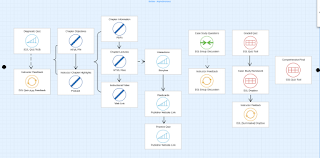Modeling Learning Environment Layers
I am working with an instructor to redesign an existing
course. The project is limited in time
and heavy on with needed revisions. The
instructor has a busy schedule and needs the project to move rapidly. I began by identifying the outcomes of the
course and the chapter modules. In the
image below you will see three pieces of evidence. Each chapter module will have a quiz and a
case study homework assignment. The
course will end with a comprehensive final.
Next, I added elements that contribute to the strategy in
the course or in other words, the pieces of information, practice assessments,
discussions and feedback.
Finally, the elements are connected using system feedback,
peer interaction and instructor feedback and the environment is identified as
online asynchronous. Each student will
begin the chapter modules with a diagnostic quiz [with auto feedback] prior to
reviewing the chapter objectives and listening to a podcast from the
instructor. Additional information is
provided and may vary from module to module.
Following multiple opportunities for practice and feedback, a group
discussion will incorporate both peer and instructor feedback. The module will conclude with a graded quiz
and a homework assignment and the course ends with a comprehensive final. This repeating pattern for the strategy and
system layers will provide much needed consistency in a content heavy course.
In conclusion, using the layer approach is helpful both for
an instructional designer and an instructor.
I used the associated questions for each layer to drive the planning
conversation with the instructor and found it made the process more efficient.



Hi Tracy, You made a great point in your post about using the questions for each layer to prompt the conversation with your "client". Were there other questions you found to be useful?
ReplyDelete